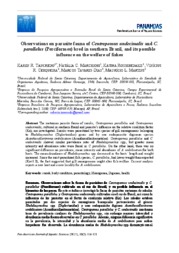Observations on parasite fauna of centropomus undecimalis and C. parallelus (perciformes) bred in southern Brazil, and its possible influence on the welfare of fishes.
Observations on parasite fauna of centropomus undecimalis and C. parallelus (perciformes) bred in southern Brazil, and its possible influence on the welfare of fishes.
Author(s): TANCREDO, K. R.; MARCHIORI, N. C.; ROUMBEDAKIS, K.; CERQUEIRA, V. R.; TAVARES-DIAS, M.; MARTINS, M. L.
Summary: The metazoan parasite fauna of snooks, Centropomus parallelus and Centropomus undecimalis, cultured in southern Brazil and parasite?s influence on the relative condition factor (Kn), are investigated. Snooks were parasitized by two species of gill monogeneans belonging to Rhabdosynochus (Diplectanidae) genus and by one endoparasitic digenean species Acanthocollaritrema umbilicatum (Acanthocollaritrematidae). Centropomus parallelus and C. undecimalis showed similar prevalence rates of Rhabdosynochus spp., but greater mean intensity and abundance rates were found in C. parallelus. On the other hand, there was no significant difference on prevalence, mean intensity and abundance of A. umbilicatumfor both hosts. The mean abundance of Rhabdosynochusspp. decreased as the hosts´ length and weight increased. Since the most parasitized fish species, C. parallelus, had lower weight than expected (Kn<1.0), the fact suggested that gill monogeneans might alter fish welfare. Current analysis reports a new host and a new locality for A. umbilicatum.
Publication year: 2015
Types of publication: Journal article
Unit: Embrapa Amapá
Keywords: Digenea, Fator de condição, Monogenea, Parasitologia, Robalo, Saúde, body condition, parasitology
Observation
Some of Embrapa's publications are published as ePub files. To read them, use or download one of the following free software options to your computer or mobile device. Android: Google Play Books; IOS: iBooks; Windows and Linux: Calibre.
Access other publications
Access the Agricultural Research Database (BDPA) to consult Embrapa's full library collection and records.
Visit Embrapa Bookstore to purchase books and other publications sold by Embrapa.

